This Midwest City is Getting Something Right—So Don't Miss It
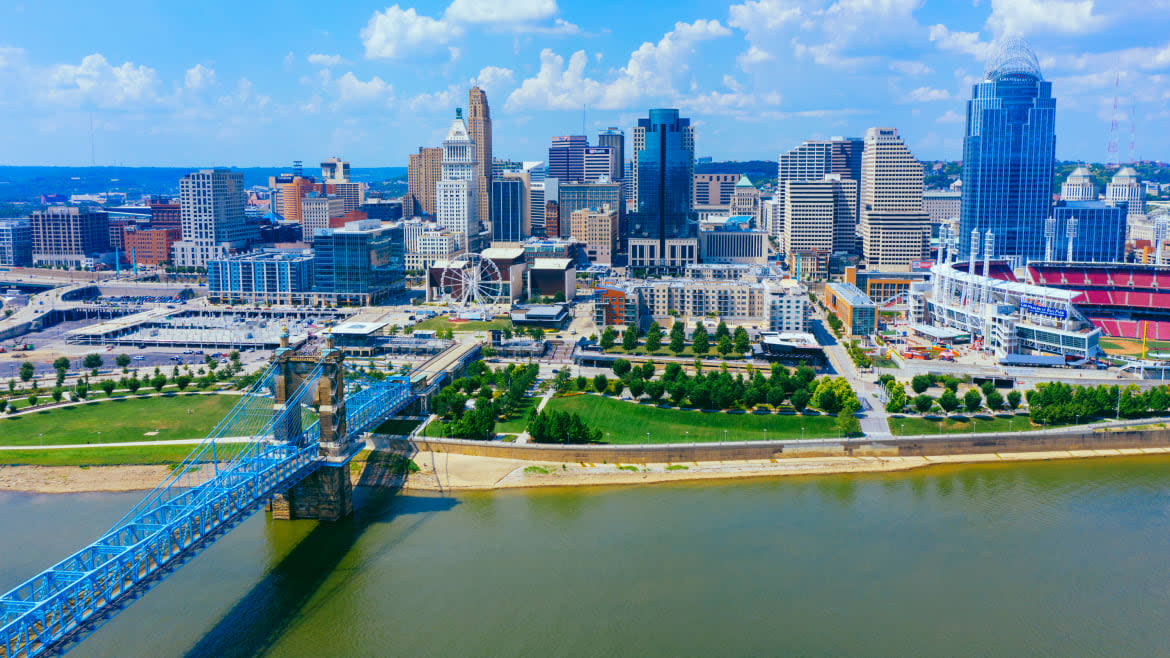
- Oops!Something went wrong.Please try again later.
It has become almost a fetish of late, visiting those once great American cities whose precipitous rise was followed by a slow demise, an attempt by modernity to kill them by a thousand cuts of highways, parking lots, globalism, and unfriendly buildings. But in those cities–Cleveland, Detroit, Tulsa, St. Louis, and so on–what was left behind by those heady decades at the top of the world is spectacular. Museums filled with loot and lucre from around the world, architecture that revolutionized our lives in concert halls, grand libraries, and palaces fit for kings and queens.
To visit those cities is to taste what it was like visiting Rome a couple of centuries ago. Visitors wandering its sometimes dangerous streets can marvel at its wonders but for the self-centered nationalist, it led to one question–what caused their fall?
While the debate about what went wrong is interesting, equally insightful is seeing a place that is getting it right. I recently found myself in Cincinnati for our series on underrated destinations, It’s Still a Big World. Like so many other mid-size American cities, Cincinnati was once at the center of the industrializing world, but as the 20th century progressed it slowly declined, a hollowing out capped off by protests and riots in 2001 after an unarmed Black teen was killed by police. But in the two decades since, the city has regained its footing, and after a few days walking all over this charming city, what became clear is that something here is working. This is not a city dwindling away, but rather thriving, intriguing, and very much alive.
When I arrived at my hotel, my room wasn’t ready, so I went for a walk, strolling around downtown Cincinnati and its Over-the-Rhine neighborhood. Cincinnati’s core is dense and its walkability has been preserved. One of the joys of these midsize cities is that you dwell on beautiful buildings, like the Enquirer building here, because they’re often one of a handful and not lost in a sea of hundreds as they can be in New York or Chicago. Over-the-Rhine, a nearly intact historical neighborhood created by largely German immigrants looks like a movie set. While block after block of Federal and Italianate 19th century storefronts and townhouses give it charm, the real treasure can be found on its walls.
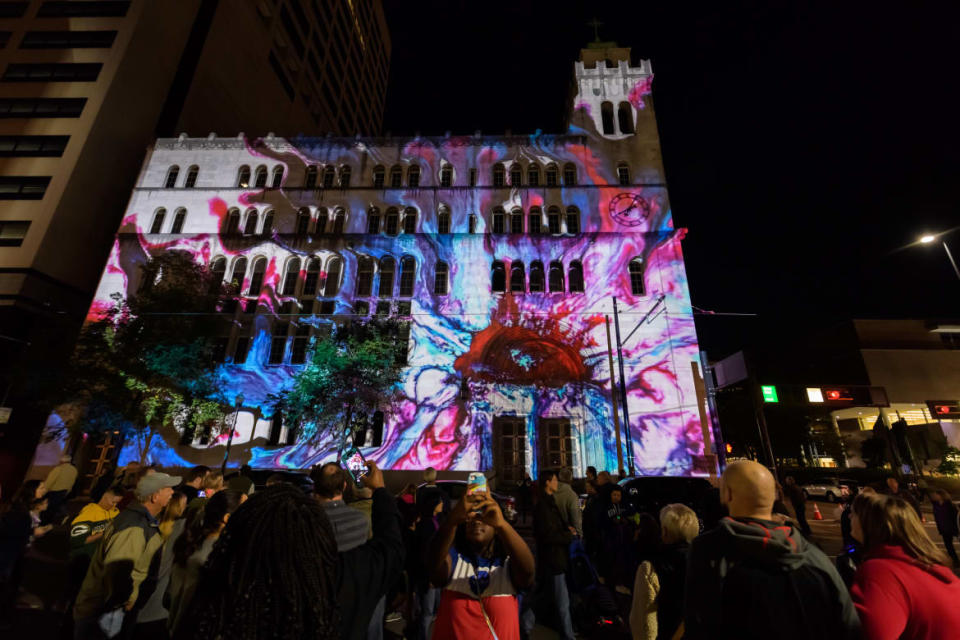
Every fall, Cincinnati is home to Blink, the largest light, art, and projection mapping festival in the U.S. Essentially, imagine large swathes of the city blanketing in light shows, augmented reality projections, and murals. While the lights fade, the murals from Blink have turned the city into a giant outdoor art gallery. There are works by big names like the Portuguese graffiti artist Vhils or Eduardo Kobra as well as dozens of by local shops and artists pulled from all over the world. Two favorites of mine included a pair of birds by Anna Marietta and the Annunciation by Xylene Projects.
The feast of art continued at my hotel, the 21c Museum Hotel. A painting by Kehinde Wiley greets you at the front desk, and art by blue chip contemporary artists fill its lobby and outside elevators on each floor. The hotel is thoroughly modern and updated and right next door to the Zaha Hadid-designed Contemporary Arts Center, which is very much of an aesthetic from the first half of her career. One note for those of you who are early to bed and light sleepers. On weekends the hotel has a club next door–but the 21c does provide one of those classic Dohm sound machines and ear plugs.
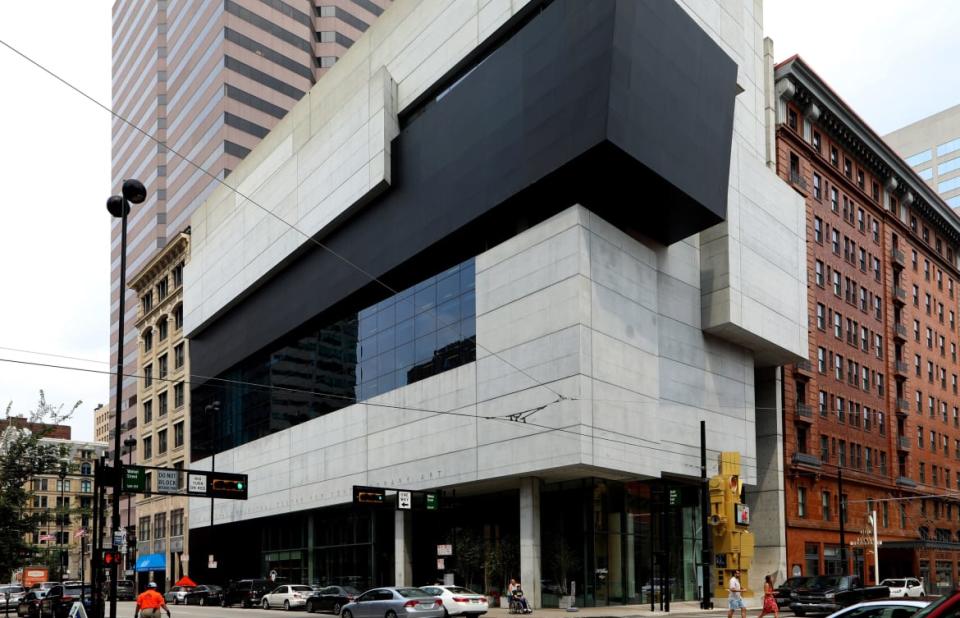
After a quick power nap and workout in the hotel’s extensive gym, I was off for dinner at Boca. Located just around the corner from the hotel, it’s a restaurant that I knew I had to try when I saw that none other than Henry Winkler himself had tweeted: “BOCCA [sic] : honest to God one of the great restaurants in this country.” It’s a multistory restaurant with a French and Italian-inspired menu. The French music playing will make you feel like you’re in a club in Call My Agent and have you whipping out Shazam. While everything I had was spot on, do go for the Pommes soufflées which are the poshest fries you’ll ever have.
Then it was a slow heat-wave-conscious walk uptown and across the restored and lively Washington Park to one of the iconic American cultural spaces, the Cincinnati Music Hall. A towering cathedral-like building in High Victorian Gothic, it was restored just a few years ago. Fortune favored the timing of my visit and I was able to attend a performance of Puccini’s La Bohème. Always check to see if something is on here when you’re in town because it really is special.
Up early because of a museum-packed day, I started out at Cafe Mochiko near the German Cemetery. The line starts early for this spot and continues throughout the morning. The menu has items like an ube halaya croissant, bbq pork snow bao, and taro mochi donuts. I tried four of the items, but my favorite was probably the kimchi & egg croissant. From there I walked back toward downtown to the Cincinnati Art Museum.
So many large art museums in the U.S. seem to think their purpose is in flexing how much “great” art from important periods of art its donors collected, and often local art or even American art generally gets relegated to less important corners. The Cincinnati Art Museum goes in the opposite direction. The main galleries on the ground floor showcase art and design from Cincinnati–Rookwood pottery, the paintings of Henry Farney and Joseph Henry Sharp, and the unforgettable mural by Saul Steinberg taken from the city’s endangered Terrace Plaza Hotel. But if you find yourself yearning for the comfort of names you might recognize, never fear: upstairs there are fabulous works by Botticelli (perhaps the silliest Judith and Holofernes ever), a Bronzino double portrait, a haunting Hopper, lithographs from the great Mexican muralists, (don’t miss Orozco’s Tourists and Aztecs), and Lalique decorative objects.
After the art museum I decided to walk to the National Underground Railroad Freedom Center, and found myself walking down a cute residential street of modern houses built into the hillside and onto a… highway where the sidewalk ended on my side. I took the families with strollers also traversing this remnant of mid-century urban planning as a sign that maybe it wasn’t all Google Maps’ fault this time and just what one had to do. I then ran the gauntlet of thousands of Reds fans arriving to the stadium which is just next door. It happened to be Juneteenth when I visited, lending a particular poignancy to the museum’s exhibits on the history of slavery and racism. Given its location just across the river from a slave state, Cincinnati was a major transit point for thousands of escaped slaves seeking freedom in the North or Canada. Don’t miss the exhibitions on modern slavery–a powerful choice on the part of the museum to make sure those of us who think this moral stain only exists in the past very much goes on today.
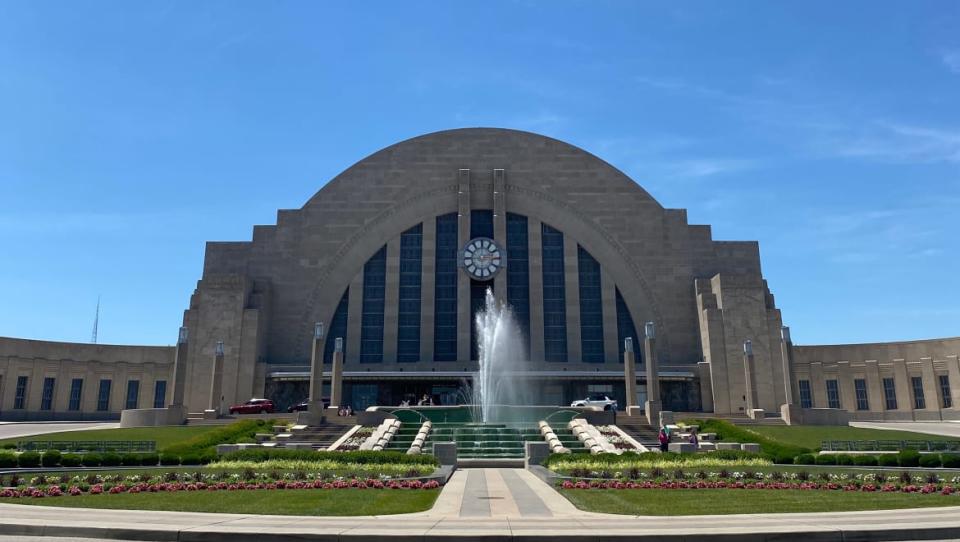
With plenty of steps in for the day, I took a Lime scooter to Union Terminal, the mega-Art Deco train station built in the late 20s on the west side of Cincinnati that must have symbolized the city’s strength to its denizens at the time but just a decade or so later its chronic underuse represented how fast things were changing. Go if only to see it–the approach is dramatic with fountains and that half circle facade that gives the whole building the appearance of a tambour mantel clock. The inspiration it drew from Eliel Saarinen’s Helsinki Central Station is obvious. Inside you will crane your neck trying to take in all of the murals and colors and shapes of the Rotunda, one of the largest semidomes in the world. More a showspace than passenger station, there are a number of museums inside including the Cincinnati History Museum, the Museum of Natural History & Science, and Duke Energy Children's Museum. The history museum intrigued me most, but while I loved poring over the scale replica of the city, the museum itself and its, um, creative approach to telling history left my thirst for understanding what happened to Cincinnati unquenched. I found myself wishing for timelines and straightforward exhibits rather than more interpretive approaches.
Back at the hotel, I killed some time watching an episode of Witcher, just to counterbalance all the knowledge I’d attempted to shove in my brain all day. Then I was off to Sotto, the sister restaurant of Bocca. Located underground with booths ringing a copper topped bar, it’s the place you want to go with your close friends for a long, boozy, dinner where the food (Italian) tastes exactly as it should and the wine to go with it is just right. Food you can savor but don’t need to dwell or dawdle over. Also, holy shit the cocktails are strong. As a reward, and to walk off those drinks, I crossed over to Kentucky on the John A. Roebling Suspension Bridge, which was once the longest in the world until Roebling’s Brooklyn Bridge. My sole mission in the new state though was ice cream, and I found a delicious spot in Golden Gelato.
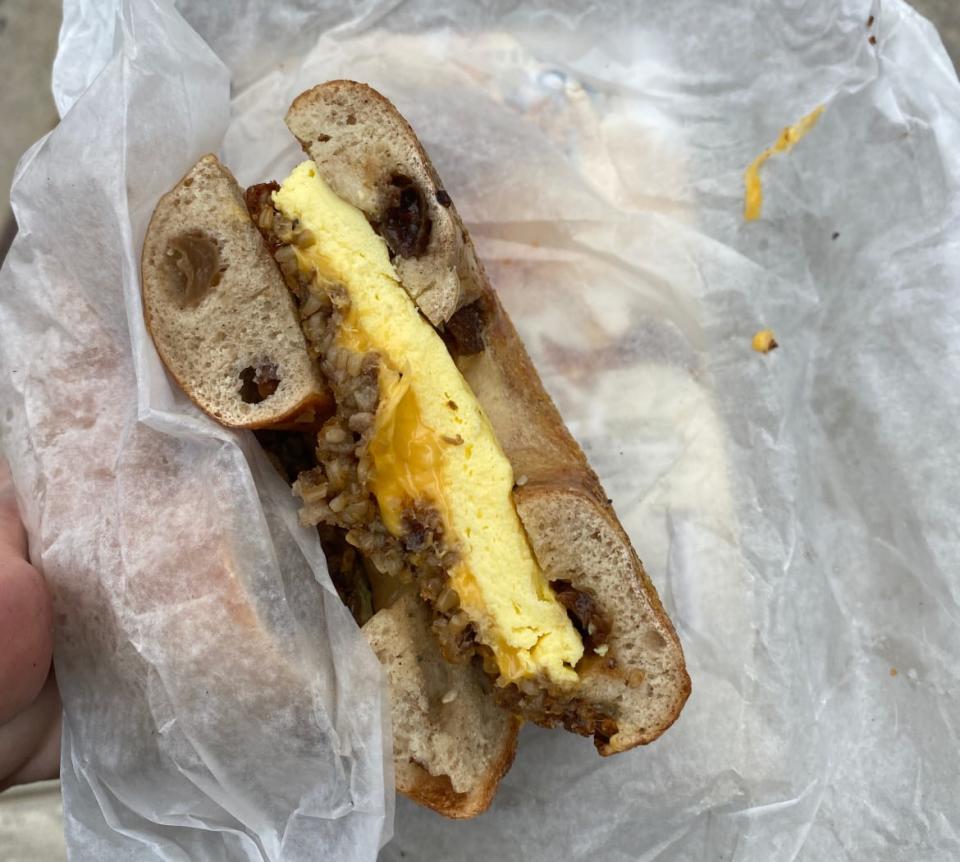
The next morning I needed something savory to start my day so I tried The Bagelry on Walnut Street. I was talked into getting a Cincinnati specialty, goetta, on my egg sandwich. It was created by the city’s German immigrants as a sort of ground meat and grains patty–and it went well with my cinnamon raisin bagel (sorry, I love them). From there I walked to a place that was at the top of my list to experience in Cincinnati–the Isaac M. Wise Temple on Plum Street. I’d wanted to come here ever since seeing it while flipping through a book on the world’s most beautiful synagogues.
But first, a couple of notes. The temple only offers tours on Thursdays and make sure to reach out with plenty of time. Second, be respectful. This is not only a community with a tremendous amount of history (Jews played a major role in Cincinnati and Cincinnati Jews played a major role for Judaism in America) but it’s also a community that finds itself once again the target of violent hate.
It’s hard to imagine, though, that once you see this temple and step inside you can be filled with anything but respect. In American architectural history we tend to take stuff seriously starting with H. H. Richardson and Richard Morris Hunt and act like they came either out of nowhere or from the leavings of Europe. But America before and leading up to them had a wonderful and eccentric architectural flavor, one that sometimes makes Hunt or McKim, Mead & White look like droll Europhiles. This temple, built in 1865, is one of those. Designed by James Keys Wilson, a protege of James Renwick, the temple is a startling fusion of Byzantine and Moorish Revival architecture. Inside it is overwhelming–not an inch left undecorated in elaborate stencilwork, metal, or carving. It is awash in color–Persian blue domes, gold, somber scarlets. And don’t miss the temple in miniature above the organ.
From there I popped over to Rookwood, the renowned pottery company started by Maria (pronounced like Mariah) Longworth Storer of the famed Longworth family. Its pottery in the late 19th century would force the artistic snobs of Europe to take the U.S. seriously as a center of design. While the shop doesn’t have the pizzazz you’d expect from a place with such a legacy, especially after seeing the astonishing array of works in the art museum, many of the contemporary one-of-a-kind pieces are absolutely fabulous. And then nearby I ended my day at the winner of multiple James Beard awards, Jose Salazar’s eponymous restaurant.
Two more must-sees remained before I departed the next day. The first was the Taft Museum of Art, a former mansion that houses the astounding collection of Anna Sinton Taft and Charles Phelps Taft, the half-brother of the president. It was once owned by Nicholas Longworth, one of the richest men in American history and if you entered it through its front doors you would first be taken aback by the richly painted murals Longworth commissioned in each of the entry rooms. They were painted by the African-American artist Robert S. Duncanson, whose “Landscape with Rainbow” was President Biden’s Inaugural painting. (I can’t for the life of me understand what exactly the Inaugural painting means, though. News accounts talk about it being given to him, but it belongs to the Smithsonian.)
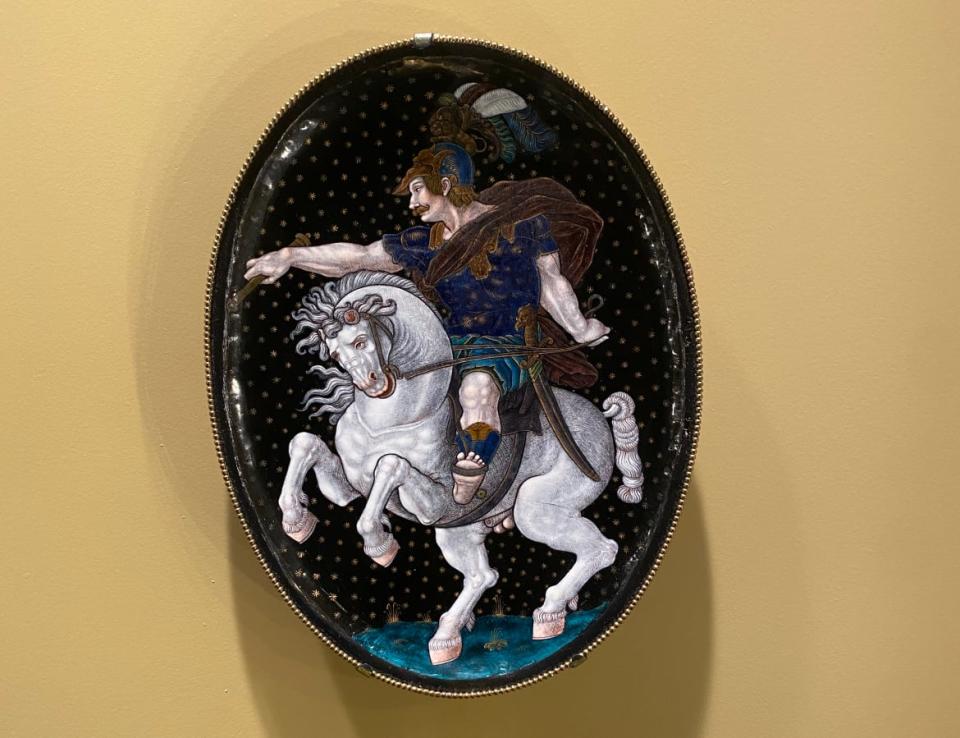
The rest of the house has been turned over to the Taft’s collection, one on par with those to be found at the Gardner in Boston or the Philips in D.C. There are pieces from Faberge, paintings by Goya, Turner, Whistler, Chinese porcelain, and one of the greatest assemblages of Limoges enamels.
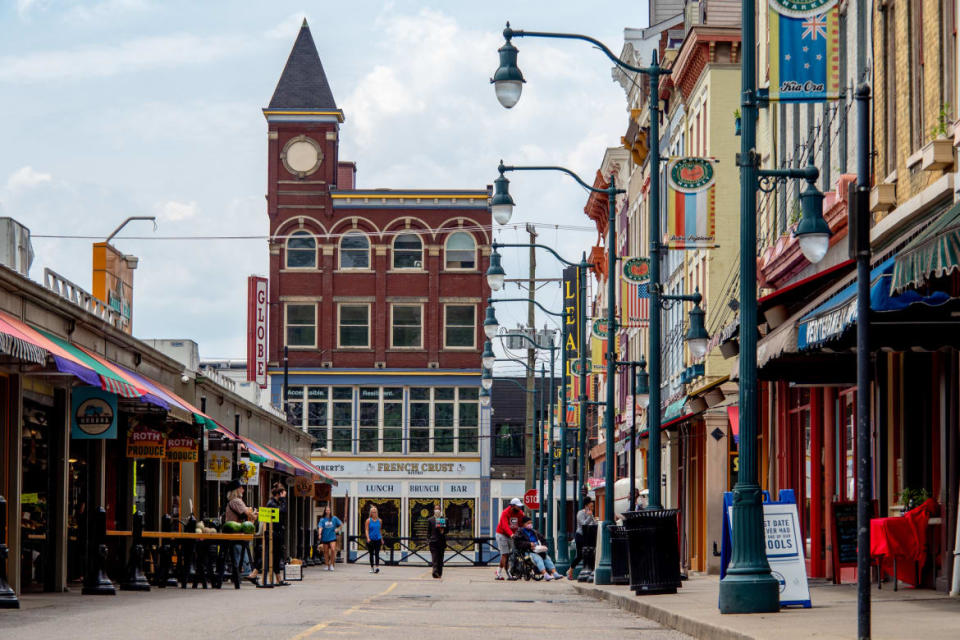
Afterwards, it was off to Findlay Market, the historic food stalls that have been maintained and are at the center of Over-the-Rhine’s renaissance. My guide was Barb Cooper of “The Original Findlay Market Food Tour” who brought me around to a butchery in the same family since the 1850s (Eckerlin Meats), an adventurous bagel shop with flavors like Flaming Hot Cheeto (OTR Bagel Bar), and a Black-owned bakery specializing in simple yet sinfully decadent cheesecakes and strawberry puddings (Makers Bakers Co.).
Walking back to the hotel from the market I could see Cincinnati is not out of the woods–you’ll pass a lot of homeless people and some empty parking lots. But the overall impression I had as a traveler was of a city that’s excited to be headed where it’s headed. In most places that you like, you can pinpoint exactly what they’ve done to make it pleasant—the riverfront has been redone, a group of chefs have made a major impact, a strong mayor forced through needed changes. In conversations with locals the impression I got in Cincinnati was a little bit of everything–artists and art lovers, determined entrepreneurs, advocacy groups, and conscientious local corporations. Whatever the mix, I’m excited to keep coming back, as there’s something going right here.
Get the Daily Beast's biggest scoops and scandals delivered right to your inbox. Sign up now.
Stay informed and gain unlimited access to the Daily Beast's unmatched reporting. Subscribe now.

